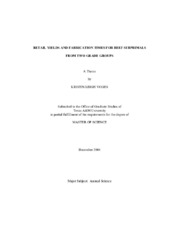| dc.description.abstract | Beef subprimals (n = 356), representing USDA Low Choice and Select grades,
were obtained from a major beef processor. Selected subprimals represented the normal
weight variation and standard packer fat trim levels associated with commodity boxed
beef. The subprimals selected included beef rib, blade meat; beef rib, ribeye roll, lip-on,
bone-in; beef rib, ribeye roll (0x0); beef rib, ribeye, lip-on (2x2) (5.08 cm x 5.08 cm);
beef rib, ribeye, lip-on modified (1x1) (2.54 cm x 2.54 cm); beef rib, ribeye (IM,
individual muscle); beef rib, ribeye cap (IM); beef chuck, outside shoulder clod,
trimmed; beef chuck, outside shoulder clod, top blade roast; beef chuck, square cut,
pectoral meat (IM); beef chuck, chuck roll; beef plate, inside skirt (IM); beef round, top
(inside) untrimmed; beef round, outside round (flat); beef round, eye of round (IM); beef
loin, strip loin, bone in; beef loin, strip loin, boneless; beef loin, top sirloin butt,
boneless, 2-piece; beef loin, bottom sirloin butt, flap boneless (IM); beef loin, bottom
sirloin butt, ball tip, boneless; beef loin, bottom sirloin butt, tri-tip, boneless (IM); and
beef chuck, outside shoulder, clod M. teres major. Subprimals were fabricated into
bone-in or boneless retail or foodservice cuts and associated components by trained
retail meat cutters. After each retail cutting test, trained technicians recorded weights of
all cuts, lean trim, fat trim, and bone. All retail cuts were trimmed to an eighth of an
inch (0.32 cm), unless otherwise specified. Time (s) was recorded for each-cutting test
and in two major phases: opening (retrieval of the subprimal from vacuum-packaged
bag) and cutting (removal of all external and seam fat, connective tissue, and separation
of individual muscles, as well as producing tray ready retail cuts). In general, Select
subprimals had higher saleable yields than Choice subprimals. Select subprimals had
less trimmable fat than Choice subprimals, and differences in retail yields appeared to
follow these factors. Few significant differences were observed for processing times
between USDA quality grade groups. These data will serve as an update to the CARDS
(Computer Assisted Retail Decision Support) software program. | en |


